 |
| 1 . |
|
The unpaired nucleotides produced by the action of restriction enzymes are referred to as _____. (Activity 12A) [Hint]
|
 |
| 2 . |
|
The sticky end of the DNA restriction fragment shown here will pair with a DNA restriction fragment with the sticky end _____. (Activity 12A)  [Hint] [Hint]
|
 |
| 3 . |
|
In order to insert a human gene into a plasmid, both must _____ (Activity 12B) [Hint]
|
 |
| 4 . |
|
What enzyme forms covalent bonds between restriction fragments? (Activity 12B) [Hint]
|
 |
| 5 . |
|
Click on the diagram to start the animation.
What name is given to the process shown in this animation? (Activity 12B) [Hint]
|
 |
| 6 . |
|
Click on the diagram to start the animation.
What name is given to the process shown in this animation? (Activity 12B) [Hint]
|
 |
| 7 . |
|
Click on the diagram to start the animation. This is an animation of gel electrophoresis. Which of these DNA molecules is the shortest? (Activity 12C) [Hint]
|
 |
| 8 . |
|
In gel electrophoresis, DNA molecules migrate from _____ to _____ ends of the gel. (Activity 12C) [Hint]
|
 |
| 9 . |
|
In this example the marker DNA includes fragments that have 23,130, 9,416, 6,557, 4,361, 2,322, 2,027, and 564 base pairs. Approximately how many base pairs are in the DNA fragment indicated by the letter A? (Activity 12D) 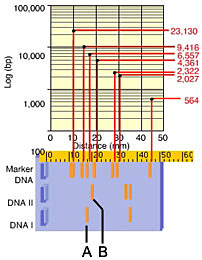 [Hint] [Hint]
|
 |
| 10 . |
|
In this example, the marker DNA includes fragments that have 23,130, 9,416, 6,557, 4,361, 2,322, 2,027, and 564 base pairs. Approximately how many base pairs are in the DNA fragment indicated by the letter B? (Activity 12D)  [Hint] [Hint]
| | between 23,130 and 9,416 base pairs |
| | between 9,416 and 6,557 base pairs |
| | between 6,557 and 4,361 base pairs |
| | between 4,361 and 2,322 base pairs |
| | between 2,322 and 2,027 base pairs |
|
 |
| 11 . |
|
DNA fragment B consists of _____ base pairs. (Activity 12D) 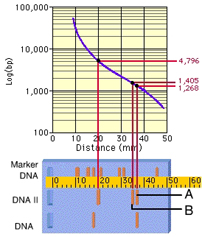 [Hint] [Hint]
|
 |
| 12 . |
|
DNA fragment A consists of _____ base pairs. (Activity 12D) 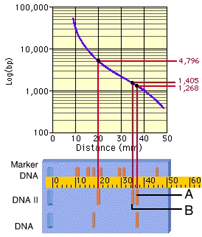 [Hint] [Hint]
|
 |
| 13 . |
|
This is a DNA fingerprint exhibiting samples from a victim, two suspects, and the crime scene. Which of these DNA fragments is common to both the victim and Suspect 1? (Activity 12E)  [Hint] [Hint]
|
 |
| 14 . |
|
This is a DNA fingerprint exhibiting samples from a victim, two suspects, and the crime scene. Which of these DNA fragments is common to both the victim and Suspect 2? (Activity 12E) 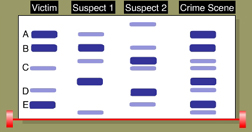 [Hint] [Hint]
|
 |
| 15 . |
|
Why is Suspect 1 considered more likely to have committed the crime than Suspect 2? (Activity 12E)  [Hint] [Hint]
|
 |
| 16 . |
|
Which of these genes are located on the q arm of chromosome 17? (Activity 12F) 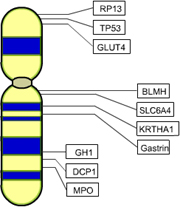 [Hint] [Hint]
|
 |
| 17 . |
|
The RP13 gene of chromosome 17 codes for a protein _____. (Activity 12F) [Hint]
|
 |
| 18 . |
|
The gene that codes for gastrin is located on the _____ of chromosome 17. (Activity 12F) 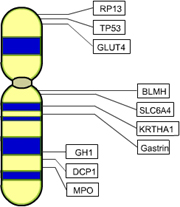 [Hint] [Hint]
|
 |
| 19 . |
|
The TP53 gene of chromosome 17 codes for a protein _____. (Activity 12F) [Hint]
|
 |
| 20 . |
|
Which of these genes codes for a protein that plays a role in growth? (Activity 12F) [Hint]
|
 |
| 21 . |
|
Which of these genes codes for a protein that plays a role in white blood cell function? (Activity 12F) [Hint]
|
 |
| 22 . |
|
Why is golden rice pale yellow in color? (Activity 12H) [Hint]
|
 |
| 23 . |
|
Which of these is a symptom of vitamin A deficiency? (Activity 12H) [Hint]
|
 |
| 24 . |
|
Which of these is a vitamin A precursor? (Activity 12H) [Hint]
|
 |
| 25 . |
|
The transfer of antibiotic-resistant genes from genetically engineered bacteria to disease-causing bacteria _____. (Activity 12H) [Hint]
|
 |
|